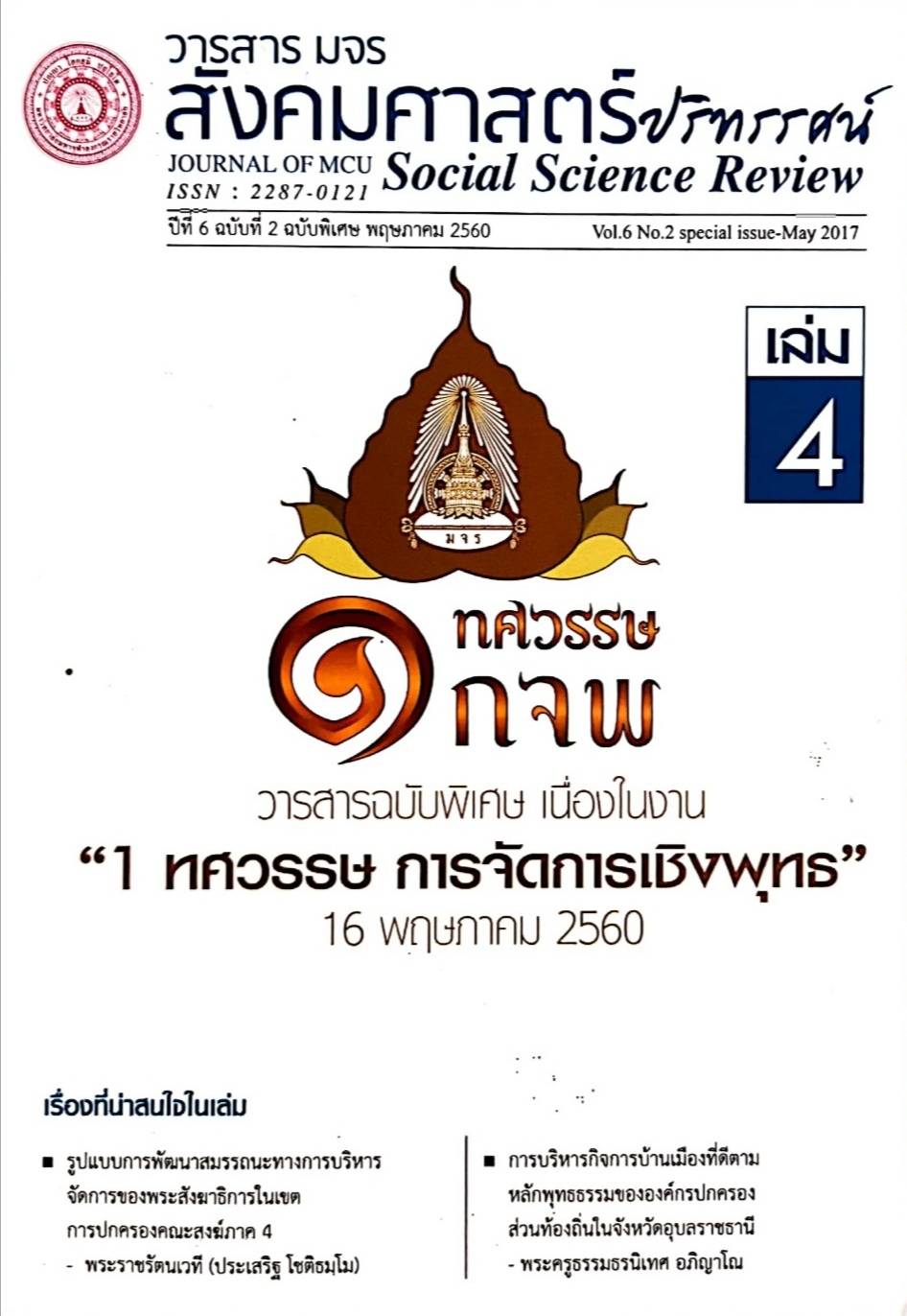รูปแบบการพัฒนาทรัพยากรมนุษย์ของพระสังฆาธิการในจังหวัดนครพนม
คำสำคัญ:
การพัฒนาทรัพยากรมนุษย์, พระสังฆาธิการบทคัดย่อ
บทความวิจัยนี้มีวัตถุประสงค์ ดังนี้ คือ 1. เพื่อศึกษาสภาพปัญหารูปแบบการพัฒนา
ทรัพยากรมนุษย์ของพระสังฆาธิการในจังหวัดนครพนม 2. เพื่อศึกษาคุณลักษณะรูปแบบการพัฒนา
ทรัพยากรมนุษย์ของพระสังฆาธิการในจังหวัดนครพนม และ 3. เพื่อนาเสนอรูปแบบการพัฒนา
ทรัพยากรมนุษย์ของพระสังฆาธิการในจังหวัดนครพนม การศึกษาวิจัยครั้งนี้เป็นการศึกษาเชิง
คุณภาพ (Qualitative Research) เก็บข้อมูลด้วย 2 ขั้นตอน คือ การสัมภาษณ์เชิงลึกแบบเจาะจง
จานวน 25 รูป เครื่องมือในการเก็บข้อมูล คือ แบบสัมภาษณ์ที่ไม่มีโครงสร้าง และจากการสนทนา
กลุ่มเฉพาะผู้ทรงคุณวุฒิเลือกแบบเจาะจงในจังหวัดนครพนม จานวน 10 รูป/คน วิเคราะห์ข้อมูล
ด้วยวิธีการวิเคราะห์เนื้อหาพรรณนาความ
ผลการวิจัยพบว่า
1. สภาพปัญหารูปแบบการพัฒนาทรัพยากรมนุษย์ของพระสังฆาธิการในจังหวัด
นครพนม พบว่า การพัฒนาทรัพยากรมนุษย์ของพระสังฆาธิการในจังหวัดนครพนม มีปัญหาและ
อุปสรรค ได้แก่ 1) ด้านการฝึกอบรม ขาดผู้นาสร้างกิจกรรม ขาดการสนับสนุนงบประมาณ 2) ด้าน
การศึกษา พบว่า การเดินทางไกล ขาดผู้ให้คาชี้แนะ และ 3) ด้านการพัฒนา
2. คุณลักษณะรูปแบบการพัฒนาทรัพยากรมนุษย์ของพระสังฆาธิการในจังหวัดนครพนม
พบว่า 1) ด้านการอบรม พบว่า เน้นการจัดโครงการฝึกอบรมรูปแบบ Workshop ประกอบด้วย 3
ภาค คือ (1) ภาควิชาการ เน้นด้านธรรมะ (2) ภาคสันทนาการ เน้นการผ่อนคลาย และ (3) ภาคจิต
ภาวนา เน้นปฏิบัติการ ฝึกสติ ฝึกสมาธิ 2) ด้านการศึกษา พบว่า บุคคลากรทาหน้าที่ในการถ่ายทอด
3) ด้านการพัฒนา พบว่า (1) กายภาวนา เน้นไปที่ความสัมพันธ์ระหว่างอายตนะภายนอกกับ
อายตนะภายใน และสร้างจิตสานึกของความเป็นพระภิกษุสามเณร (2) ศีลภาวนา เน้นเสขิยวัตร
กิจวัตร กฎหมายทางโลก ธรรมเนียม จารีต ประเพณี การปฏิบัติ (3) จิตภาวนา เน้นไปที่ การพัฒนา
จิต สมถกรรมฐาน วิปัสสนากรรมฐาน และ (4) ปัญญาภาวนา เน้นการฟัง การคิด การภาวนา และ
การสร้างสังคมแห่งการเรียนรู้
3. รูปแบบการพัฒนาทรัพยากรมนุษย์ของพระสังฆาธิการในจังหวัดนครพนม พบว่า
ระดับต้น เน้นการพัฒนากายมีคุณภาพ (Quality) ประกอบด้วย 1) การพัฒนาอายตนะ 6 2) การ
พัฒนาด้านสุขภาวะ และ 3) การพัฒนาด้านอิริยาบถ ระดับกลาง เน้นการพัฒนาศีลมีคุณความดี
(Merit) ประกอบด้วย 1) ด้านกิจวัตร 2) ด้านพระวินัย 3) ด้านปฏิสัมพันธ์ทางสังคม ระดับสูง เน้น การพัฒนาจิตมีคุณธรรม (Moral) ผ่านโครงการการอบรม การศึกษา และการพัฒนาทรัพยากร
มนุษย์ 4 คืน 5 วัน ประกอบด้วย 1) ภาควิชาการ 2) ภาคสันทนการ และ 3) ภาคการพัฒนาจิต
เอกสารอ้างอิง
กรุงเทพมหานคร : ธรรมสภา.
ณัฏฐพันธ เขจรนันทน. (2545). การจัดการทรัพยากรมนุษย. กรุงเทพมหานคร : ซีเอ็ดยูเคชั่น.
สานักงานเลขาธิการสภาการศึกษา. (2547). การพัฒนาองค์กรและบุคลากรแนวคิดใหม่ในการ
พัฒนาทรัพยากรมนุษย์. กรุงเทพมหานคร : 21 เซ็นจูรี่.
พระธรรมโกศาจารย์ (ประยูร ธมฺมจิตฺโต). (2549). พุทธวิธีในการบริหาร พิมพ์ครั้งที่ 4.
กรุงเทพมหานคร : โรงพิมพ์มหาจุฬาลงกรณราชวิทยาลัย.
พุทธทาสภิกขุ. (เป้าหมายของการศึกษา). กรุงเทพมหานคร : สานักพิมพ์นิพพาน, 2537.
กรมการศาสนา. (2542). พระสังฆาธิการว่าด้วยพระราชบัญญัติ กฎ ระเบียบและคาสั่งของคณะ
สงฆ์กรุงเทพมหานคร : โรงพิมพ์การศาสนา.
ดาวน์โหลด
เผยแพร่แล้ว
รูปแบบการอ้างอิง
ฉบับ
ประเภทบทความ
สัญญาอนุญาต
ลิขสิทธิ์ (c) 2020 วารสาร มจร สังคมศาสตร์ปริทรรศน์

อนุญาตภายใต้เงื่อนไข Creative Commons Attribution-NonCommercial-NoDerivatives 4.0 International License.
เพื่อให้เป็นไปตามกฎหมายลิขสิทธิ์ ผู้นิพนธ์ทุกท่านต้องลงลายมือชื่อในแบบฟอร์มใบมอบลิขสิทธิ์บทความให้แก่วารสารฯ พร้อมกับบทความต้นฉบับที่ได้แก้ไขครั้งสุดท้าย นอกจากนี้ ผู้นิพนธ์ทุกท่านต้องยืนยันว่าบทความต้นฉบับที่ส่งมาตีพิมพ์นั้น ได้ส่งมาตีพิมพ์เฉพาะในวารสาร มจร สังคมศาสตร์ปริทรรศน์ เพียงแห่งเดียวเท่านั้น หากมีการใช้ภาพหรือตารางหรือเนื้อหาอื่นๆ ของผู้นิพนธ์อื่นที่ปรากฏในสิ่งตีพิมพ์อื่นมาแล้ว ผู้นิพนธ์ต้องขออนุญาตเจ้าของลิขสิทธิ์ก่อน พร้อมทั้งแสดงหนังสือที่ได้รับการยินยอมต่อบรรณาธิการ ก่อนที่บทความจะได้รับการตีพิมพ์ หากไม่เป็นไปตามข้อกำหนดเบื้องต้น ทางวารสารจะถอดบทความของท่านออกโดยไม่มีข้อยกเว้นใดๆ ทั้งสิ้น





